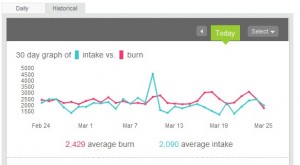If you’re cooking your own meals instead of buying premade meals or eating out then you’ve already taken the first step in living a healthy lifestyle. But while home cooked meals are generally better for you, it’s not the only thing you need to do. In this section I’ll talk about other topics that are as important as cooking for yourself in order to stay in shape, control your weight and improve your overall health. I’ll also provide links to books and websites that I’ve found useful.
Weight Control
First of all, it’s not just about losing weight and secondly it’s not about dieting. It’s actually very simple: you have to burn more calories then you eat. Now I’ll be the first to admit that this isn’t something new. And knowing that didn’t keep me from gaining 40 pounds over the last 30 years. But it does hold the key to gaining control and reversing the trend that seems to inevitably start when our metabolism slows down. I’ve found that there are only three things you need to do to get your weight under control.
- You have to know how much you eat. Pretty simple really, if you don’t know how many calories are in the meals you’re eating then you can’t possibly be in control. If you’ve been following my blog, then you’ll probably have noticed that I initially didn’t have any nutritional information with my recipes. I’ve been going back over them and updating them. Having the calories for an entire meal makes it a lot easier to track then entering the entree and each side.
- You have to know how many calories your burn off each day. If your serious about this, then go and get yourself a fitbit. You wear it all day and it keeps track of how many steps you take, how many stairs you climb and calculates how many calories you burn off.
- The last step is to make sure you eat less then you burn off. Now that you’re keeping track you know that if you skip the workout at the gym, then you better skip that bowl of ice cream after dinner. Using your fitbit is a big help here as it plots both of these and you just need to keep the red line (calories burned) over the blue line (calories eaten).

Diet
Half of the equation to weight loss is our diet. I didn’t say dieting, dieting is a trap. What we’re looking for is a diet that is healthy, satisfying and meets our goal of keeping that blue line below the red line.
When I started looking at my recipes and adding the nutritional data I was rather surprised to find that I could eat a healthy meal that was under 800 calories or I could have a dinner that was almost double that. Since I tend to expend about 2400 calories a day, I need a diet that averages less than 2400 calories. Since dinner is my largest meal of the day, I’ll be looking to keep most of my recipes under 1000 calories for the meal, with many around 800 calories.
The 4-Hour Body by Tim Ferris (http://fourhourbody.com/) recommends a slow-carb diet which focuses on the glycemic load of the food and promotes eating more complex carbohydrates and less refined foods. Tim goes a step further and looks at when and what to eat to mazimize the positive affects of the diet. I recommend reading this book as starting point on focusing on living a healthier lifestyle.
I’ll be adding more recipes to my collection that have a calorie count in the 800 calorie range and have a low GL. The good news is that these tend to be fall in the Mexican and Indian categories. If you want to calculate the GL of your recipes I use the Nutrition Data website at Self magazine (http://nutritiondata.self.com/) to calculate the nutritional values of all my meals.

